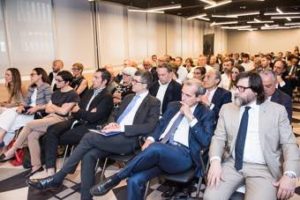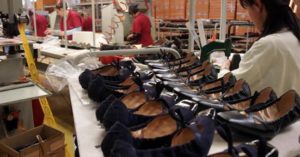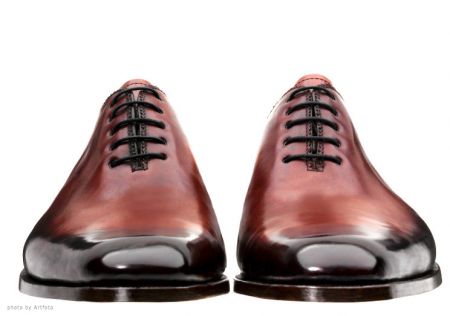A highly unusual Assocalzaturifici National Assembly, characterised by a private formula, was held this past 19 June, bringing its members together in the new Confindustriale headquarters of via Alberto Riva Villasanta to discuss sector data for the beginning of 2018. Alongside the Association’s initiatives, there was also the presentation of the results that emerged from the study dedicated to generational turnover in sector companies. In front of Confindustria Moda President Claudio Marenzi, and the Assocalzaturifici management team and its members, President Annarita Pilotti spoke of an economic context for the footwear industry that is still full of light and shadows: “2018 began with a slowdown in foreign sales and production rhythms. Exports recorded a weak rise of +0.1% in value, but fell by more than -3% in volume, when compared to the same period la st year. Additionally, the difficulties being experienced in some international end markets are cause for worry. In particular, in the CIS area, the recovery that began in 2017 has come to an abrupt halt, with a -7% drop in value and -2% fall in quantity recorded during the first three months of 2018. Russia, instead, has experienced an overall -10% decrease. There is also a slowdown in the Far East (-6.3% in value), where the further growth of China and South Korea has not been enough to compensate for losses in Japan and Hong Kong”.
st year. Additionally, the difficulties being experienced in some international end markets are cause for worry. In particular, in the CIS area, the recovery that began in 2017 has come to an abrupt halt, with a -7% drop in value and -2% fall in quantity recorded during the first three months of 2018. Russia, instead, has experienced an overall -10% decrease. There is also a slowdown in the Far East (-6.3% in value), where the further growth of China and South Korea has not been enough to compensate for losses in Japan and Hong Kong”.
2017 had created high hopes for an eventual recovery, with its positive indicators, especially in terms of production, which arrived at more than 190 million pairs, while export values recorded their best performance of the last 15 years at 9.2 billion euros; with the foreign trade balance up +8.5% from 2016 at 4.54 billion euros. All these factors pointed towards what should have been a much stronger recovery in 2018. Instead, it has only been a great disappointment so far.
With a modest performance in foreign sales, exports during the first quarter 2018 remained nevertheless a driving force for the sector, which is still dealing with a domestic market that has remained stag nant for a number of years.
nant for a number of years.
Among the Made in Italy footwear end markets, the EU remains the main one, where 7 out of 10 pairs are destined, with values holding steady at +0.3%, while volumes are down by -6%. Moreover, a drop of more than 10 percent in export volumes has characterised the negative performance of key markets like France, Spain, Belgium, and the Netherlands. Instead, the performance of non-EU markets has been full of highs and lows, with steady values and volumes on the rise by +3.9%, in an overall trend that expands upon the positive dynamics of 2017. Going more into detail, Switzerland reinforces its role as a logistics hub also for footwear, recording a +10% increase in volumes and values. In North America, there is an increasingly large gap between positive volumes and negative values in the USA (+10% and -10.2% respectively), while Canada registers a double-digit rise in quantity (+23%), maybe also because of the provisional entry into force of CETA. In the Far East, instead, there is a continuation of the negative downtrend made up by its four main end markets. The only area where there is a tendency to move away from last year’s trend is in the CIS area, which takes a huge step back from the +23% in volume and +15.3% in value registered in 2017, while what had seemed like the beginning of a very promising recovery in Russia is interrupted.
interrupted.
Imports, instead, are once again on the rise, with an important +5% increase in volumes and values, and an incredible 10% increase in the import volumes of our first supplier, China. Despite these dynamics, the Italian trade balance remains very favourable at 1.069 billion euros, notwithstanding the -6% downtrend from the same period in 2017.
The footwear industry is not new to challenges and member companies interviewed before the National Assembly all agree that the USA market has the best potential for growth in the months to come, pointing out strategies like research on new markets, cost optimisation, and product innovation as key to overcoming the current economic trend.
Caution must be taken however in thinking the situation is only short-term: among the member companies interviewed, orders booked during the first 4 months of 2018 have dropped-off both internationally (-1.9%) and nationally (-1.1%).
This difficult moment is also aggravating the problems of companies and the workforce crisis: after a 2017 with a loss of -131 businesses and -144 employees, the first quarter registers the closing of an additional 45 footwear companies and a further 331 jobs lost.
As to the future of footwear manufacturers, Assocalzaturifici decided to take a closer look at the delicate phase of generational turnover by having the LIUC Business School under take a dedicated study, with the results presented at the Assembly: “The study, Family-run businesses? A genuine enterprise!– declares Annarita Pilotti – demonstrates how for sector companies true continuity is represented by the change that youths raised in entrepreneurial families can impart to these businesses, if given the freedom to express themselves and innovate with regards to the company’s organisational structure”. In a context where around 70% of family-owned businesses do not survive beyond the first generation and less than 10% arrive at only fifty years of activity, it’s important to avoid traps like familism, immobilism, and excessive closed-mindedness to outside influence. Instead, the focus should be on “instilling a sense of responsibility among members of the family, undertaking the right educational pathway, engaging the support of non-familial third-parties, and a continuous analysis of leadership models” as key factors to the company’s success.
take a dedicated study, with the results presented at the Assembly: “The study, Family-run businesses? A genuine enterprise!– declares Annarita Pilotti – demonstrates how for sector companies true continuity is represented by the change that youths raised in entrepreneurial families can impart to these businesses, if given the freedom to express themselves and innovate with regards to the company’s organisational structure”. In a context where around 70% of family-owned businesses do not survive beyond the first generation and less than 10% arrive at only fifty years of activity, it’s important to avoid traps like familism, immobilism, and excessive closed-mindedness to outside influence. Instead, the focus should be on “instilling a sense of responsibility among members of the family, undertaking the right educational pathway, engaging the support of non-familial third-parties, and a continuous analysis of leadership models” as key factors to the company’s success.
At the end of the Assembly, the sector is now ready to make preparations for its rendezvous at the next edition of Micam, the trade fair platform that serves as an important resource in the international promotion of Made in Italy footwear.




